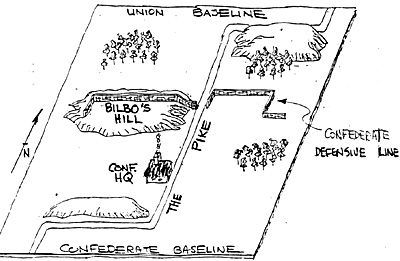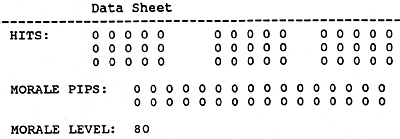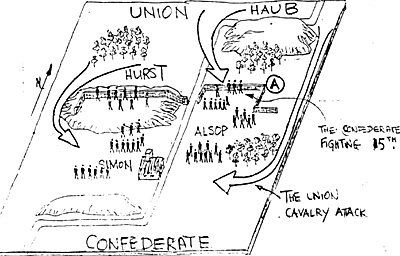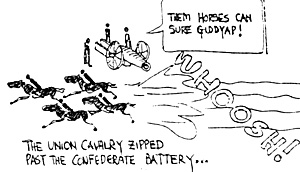Does the commander of a force always know the full status of each of the units under his command? With the assumption that the answer is "no". we developed and played a set of ACW rules in which a degree of uncertainty was built in concerning the current condition of the morale level of a unit.
Each unit - call it a regiment - started out with 10 figures, i.e. , 10 men. Each time a regiment was hit by enemy fire or engaged in melee, it received a number of pips which were recorded on its data sheet.
For every accumulated five pips, one figure was removed. Thus the commander easily saw the physical decrease in the size of his forces due to combat. What he didn't see, however, was how the pips, i.e., the hits, affected the regiment's morale level.
Each regiment was given an initial morale level of 80%. Each pip deducted from this level, but the exact extent remained unknown until one of two situations occurred:
- The regiment was required to test morale, or
The regiment engaged in melee.
The way the rules were initially formatted, each commander, each turn, received a number of Staff Points (SP) which he then had to expend issuing orders to move, to fire, to charge, to rally, etc. If, during a turn, he ran out of SP... tough! ... his troops were immobile and he waited until next turn's "replenishment" phase occurred. On the other hand, he was allowed to accumulate excess SP from turn to turn which then permitted him to save up for the "big push".
 First Playtest
First Playtest
In the very first playtest, this format proved way too restrictive; it appeared that only half the troops were moving/firing, as the commander poured his SP into the front rank units alone. Units in the rear were ignored or forgotten while the front rankers beat each other to death.
Quickening the pace of the game was achieved by restricting SP only for "special actions". Here, all units were permitted to move or fire at least once per turn without any allocation of SP. When, however, a "special action" was called for, then one or more SP had to be assigned to the unit involved. These special actions were:
- Rapid fire 2 SP
Charge to contact 2 SP
Add'l move or fire 1 SP
Add 5% to unit's morale level 1 SP
Eliminate 2 morale pips 1 SP
We set up a battle as in the diagram. On the Union side were Bob Hurst and Fred Haub, commanding 11 units:
- First Brigade 4 regiments
Second Brigade 3 regiments
U.S. Cavalry 3 regiments + 1 gun
The Southerners were handled by General Simon, the Lion of the Confederacy, and by Dave Alsop, a newly arrived British person, known far and wide as the sculptor of the OLD GLORY MINIATURES line of 25mm figures, which have been on the market for a little over a year. The Southern forces, 8 units in all:
- Griggle's Brigade 3 regiments + 1 gun
Fougle's Brigade 4 regiments
The Confederates, outnumbered, were on the defense; one unit, the 3rd, held the wall atop Bilbo's Hill, while another, the 15th, was at the wal.1 just to the east of the Pike.
We played seven full turns, at the end of which the Yankees had successfully beaten the Rebs to a frazzle... perhaps half a frazzle... I'm not sure of the rate of exchange.
Whenever a regiment tested its morale for the first time, the following was done:
- a.For every pip on the unit's data sheet, draw one
card from a 16 card deck. The deck held four each of
1,2,3,and 4.
b.Total the card values and subtract this total from the current base morale level of 80% to obtain a new base morale level. The unit now tests at this new level.
c. Cross out the 80% and note the new level on the data sheet... this now becomes the unit's new base morale level.
As the game continues, the regiment will accumulate more pips. when the next morale test is called for, cards are drawn for these new pips, and the base morale level adjusted accordingly.
In this manner, while the current base level is always known,-the presence of pips signifies a further decrease in morale, yet the extent of the decrease is not known until the test is made.
The Staff Points (SP) permitted a commander to assist a unit, raising its morale level, in two ways:
- a.He could spend 1 SP and remove 2 pips from the data
sheet, BEFORE the cards were turned over and the pips
translated into a specific percentage.
b.He could spend 1 SP AFTER the card values were exposed and the base morale level adjusted, and increase the unt's morale level by 5%.
Note that the average value of a pip, when the cards are drawn, is 2.5, hence on the average, two pips equal 5%. Thus under (a) above, by eliminating two pips at a cost of 1 SP, the morale level increases by 5%. For the same 1 SP, under (b) , the morale level goes up by 5%.
The result appears to be a wash, i.e., there's no advantage in choosing (a) over (b) . But there is one effect that doesn't readily show up and that is very significant during the battle. If one ignores a pip and goes the (b) route, THEN THE PIP REMAINS, and affects every subsequent morale check during its existence. It is only by "buying off" a pip that its effect can be eliminated.
As an example, assume the 99th regiment has a current morale level of 70%, plus two pips, and it's time to test morale:
- a. One can spend an sp, eliminate -the pips, and the
99th's morale level remains at 70%.
b. One can turn over two cards - one for each pip - assume a "3" and "4" show up. The morale level of the 99th is now (70-7), or 63%. But since the pips still exist, the next time the 99th tests, another two cards will be drawn... and the pips will haunt the 99th forever.
The game mechanics were relatively simple. A seven card deck, randomly shuffled, governed the sequence:
- Card No 1 Union, move or fire
No 2 Union, move or fire
No 3 Conf, move or fire
No 4 Conf, move or fire
No 5 Union, morale test
No 6 Conf, morale test
No 7 Commanders resupply Staff Points
When one unit charged another, the melee was fought at the end of the card FOLLOWING the one on which the contact was made.
When the "Union, move-or-fire" phase appeared, all Union regiments were activated. Infantry moved 8 inches, cavalry 12 inches, and musket range was 15 inches. If the 99th, for example, was 12 inches from an enemy regiment, an expenditure of 2 SP permitted it the extra movement to contact. If it started at 8 inches, away (its normal move), then 2 SP could produce a rapid fire, followed by another 2 SP for the charge to contact.
When firing, each firing figure modified the dice throw as follows:
- Regular fire (3 x No of men firing)
Rapid fire +(10 x No of men firing)
The hit, or pip, table looked like:
- Modified Dice
01 to 60 No hits
61 to 120 1 hit
Over 120 3 hits
 Each hit was recorded under both the HIT category and the MORALE
PIP category on the data sheet. Under HITS, every 5 boxes resulted in
one f igure removed; these hits could not be "bought of f 11 as could
the morale pips. When cards were drawn, and the pips converted into a
percentage decrease in morale, this was recorded under MORALE LEVEL.
Each hit was recorded under both the HIT category and the MORALE
PIP category on the data sheet. Under HITS, every 5 boxes resulted in
one f igure removed; these hits could not be "bought of f 11 as could
the morale pips. When cards were drawn, and the pips converted into a
percentage decrease in morale, this was recorded under MORALE LEVEL.
Data Sheet
As for the game, the decisive force proved the U.S Cavalry, well led by General Haub. The cavalry sat in its initial position on the northeast corner of the field for about half the game, immobile.
We all forgot about its existence... all, that is, except General Haub, who, each turn, carefully hoarded the cavalry Staff Points (SP) until he had about a thousand of 'em. He then sent the entire three regiment brigade forward in a series of double moves (2 SP per 24 inch move) as indicated on the map, swooping in on the Rebels near their Headquarters.
 The U.S. Cavalry Brigade had a gun in its order of battle,
and this weapon, although listed under Haub's cavalry roster,
was given to the good General Hurst. This proved an
interesting exercise in COMMAND and CONTROL.
The U.S. Cavalry Brigade had a gun in its order of battle,
and this weapon, although listed under Haub's cavalry roster,
was given to the good General Hurst. This proved an
interesting exercise in COMMAND and CONTROL.
Hurst had CONTROL of the gun... he ordered it to go here and there, limber and unlimber, load and fire, etc.,... and he was forever requesting additional SP for the gun from Haub. Since the gun was brigaded with the cavalry, Haub essentially had COMMAND of the gun... he could allocate its SP where and when he wanted.
General Hurst was in continual need of artillery fire support; the one action permitted the gun, only allowed it to fire in regular fashion. He would have liked a few extra SP which would have let him double-move, or double-fire, or (heavens!) double-rapid-fire!
But... no! General Haub sat hunched over the cavalry brigade's SP total, guarding them with his life, awaiting the turn he could send the troops forward. Cavalry... si! Artillery... no!
Aside from the Union internal-staff squabbling about granting the artillery additional actions via an extra SP or so, both Union commanders seemed to have no great problems concerning their supply of SP.
On our Confederate right flank, Dave Alsop, in terms of his SP, seemed to alternate between periods of drought and plenty.
Once each turn, a new supply of SP for each brigade was diced for. If N is the number of units in the brigade:
- Dice
01 to 33: SP=1/2N (round up)
34 to 66: SP=N
67 to 100: SP=1.5N (round up)
Dave had four regiments in his command, which meant he could get, each turn, either 2, or 4, or 6 SP, and for a while, he tossed some fairly high dice. A 5% augmentation in unit morale level cost 1 SP, land this enabled him, at one point, to raise the morale levels of his units to "beyond exuberance" ... if you've got it, spend it, was his motto... one unit was lofted to a morale level of 110%!
This parlicLar unit was the Fighting 15th and,.I must admit, they needed all the exuberance they could muster. The 15th was an undersize 5-man regiment, as opposed to the 10-man rosters of the other regiments. The 15th stood at the wall at Point A on the map, defending it against all odds. At the outset of the battle, they were fired on, tested morale, thought better of their front-line position and fell back... but a few soft words in the locker room from Coach Alsop, and they returned, more determined than ever.
Coach Alsop's words must have meant much for his men, for the Fighting 15th was charged twice, and each time managed to beat back the attackers, retaining their position at the wall. The melee procedures, whereby the 15th fought off the oncoming Yankees, may prove of interest. The procedure was pure "Milton Bradley", and those of you familiar with the M-B game DOGFIGHT, might recognize a similarity or two.
- First, each side drew 3 cards from a "Melee Deck". the
contents of which were four of each: 1,2,3, and 4.
Second, each unit totaled two factors to come up with a number of points, P:
- + 3 x (no of men in regiment)
+ Unit's current morale level
Third, if the unit had an advantage over the attacker, it would add to the above:
- + 5 x (10-sided die roll)
Fourth, once the total, P, was obtained, every 20 points entitled that side to draw an additional card to add to the original 3.
Fifth, each side now selected 3 cards from all the ones they held.
Sixth, the 3 cards were played, one at a time, and compared with the opposition's, in three consecutive rounds. He who won two of the three won the melee.
All present liked the procedure, had a good time with it, and enjoyed the tension created as each side compared cards in the three rounds... but all agreed the calculations slowed up the game, and so the next version of these rules will jetison the calculations.
I have spoken of the Union's SP antics, and Dave's SP supply, and now a word about my own SP requirement. In 6 of 7 turns, when dicing for the SP supply of my 4-regiment command, Griggle's Brigade, I came up short... only 2 SP appeared.
Which meant that as the Yankees came determinedly up Bilbols Hill toward my defending regiment, the 3rd Whapaloosas, they could rapid fire only once... and that was it! The 2 SP inventory was eaten up and the rest of Griggle's Brigade was relegated to the "one move" or "one fire" routine. Which also meant that I couldn't call on any units to double-move to fill the gaps caused by my backtracking units, as Hurst's First Brigade closed in on the Rebel Headquarters.
The lack of SP did more than hold up movement of my units, for it also meant that I had no SP to "buy off" the morale pips on the unit data sheet. For example, one of my regiments, the 311th, by the end of the game, had accumulated 16 pips. Each time the 311th tested its morale, therefore, 16 cards were drawn and the total subtracted from the morale base of the 311th, And if the regiment failed, yet another pip was added, and another 5% subtracted from the morale base.
An SP deficit could thus escalate into a disease from which recovery was doubtful. A hindsight judgement - applicable to the next "edition" - might be that the SP requirement was TOO effective, Perhaps an overkill. At least, so it seemed to ME, if not the other participants ... I was hoist with my own petard.
Somehow, nothing seemed to go right for me in this battle. For example, I brought out my single artillery piece from the baseline and placed it at the wall beside the Fighting 15th. After 2 turns of seeing no targets at all, I decided that perhaps this was not the optimum location for the gun. The cannon finally found a home not too far from our Headquarters, where it fired rather desultorily once or twice as Haub's cavalry galloped by.
 This gallop brought up an interesting question by Dave Alsop
concerning the alternating movement sequence. Haub's cavalry,
bolstered by lots of SP, made their double moves in large, quantum 24-
inch leaps. This carried them right across the front of the artillery
piece, without the gun being able to fire a single shot. Dave inquired
as to "pass through" fire, but there was no provision in the rules for
this. In looking back at the sequence, I believe I shall take Dave's
comment to heart; some sort of "pass through" fire provision shall be
tossed in...not an "automatic fire", but one in which the chance to
fire depends upon the reaction factor (morale?) of the unit.
This gallop brought up an interesting question by Dave Alsop
concerning the alternating movement sequence. Haub's cavalry,
bolstered by lots of SP, made their double moves in large, quantum 24-
inch leaps. This carried them right across the front of the artillery
piece, without the gun being able to fire a single shot. Dave inquired
as to "pass through" fire, but there was no provision in the rules for
this. In looking back at the sequence, I believe I shall take Dave's
comment to heart; some sort of "pass through" fire provision shall be
tossed in...not an "automatic fire", but one in which the chance to
fire depends upon the reaction factor (morale?) of the unit.
At game's end, the Union forces had captured Bilbols Hill, had captured our Headquarters, had pretty much rounded up the entire Rebel army, and had elucidated a comment from Dave to the effect: "You're rather weak on generating a balanced scenario, aren't you?"
I brushed this off, stating that I had purposely unbalanced the sides in favor of the Yankees because Hurst and Haub always get nasty and surly when they lose, and as they get cranky, they begin to bend my figures back and forth at the knees, breaking them off the bases. Dave accepted this; in fact, looking at Hurst and Haub across the table, I began to believe it myself.
Back to PW Review February 1990 Table of Contents
Back to PW Review List of Issues
Back to MagWeb Master Magazine List
© Copyright 1990 Wally Simon
This article appears in MagWeb.com (Magazine Web) on the Internet World Wide Web.
Other articles from military history and related magazines are available at http://www.magweb.com